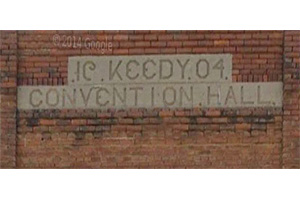
 |
 |
|||||||||||||||||||||||||||||||||||||||||||
Wikipedia notes what happened lately:
It's completely closed now. The company said it was not competitive with "other smelters globally." The town grew up alongside a train line, the International-Great Northern Railroad. Their depot:
I wondered what the Great Snortin' was doing down in Texas, but the famed Minnesota line was a different company. The Great Northern Railway. I'm sure they didn't chose the name of the Texas line to make people think they were part of that successful company. Nah.
So what's downtown? This off-putting piece of visual abrasion:
A facade job, or new construction? The door is situated like a 60s building, and the same goes for the window. If I had to guess: bank or public building of some sort. It's certainly arresting, I'll give it that. NOTE: in the middle of writing this, I found a resource that gives some context. It seems to have replaced another structure.
Full enshinglement in the Buckaroo Revival style, with late 60s / early 70s faux stone for the full length:
Think of men with wide lapels and thick ties and brown-rimmed glasses and combovers and polyester shirts, and that's who clustered around the day they had their grand opening.
As the song says: something's happening here. What it is ain't exactly clear.
It looks like a second floor was lopped off and the windows filled in, but the proportions are wrong, and the roofline pyramids look original.
The town went all-out when it seemed like Pepto-Bismol might build plant:
Thin bricks indicate a 50s makeover; the corners show the tell-tale signs of glue daubs, suggesting Vitrolite or porcelain plates. Which might have been put up in the 30s or 40s. Overall it looks as if it lost a story - the second, in between the first and third.
The building on the left looks like an indifferent Rock 'em-Sock 'em robot:
On the right - why, look! Buckaroo Revival of the most delicate sort.
Yes, that's a great place for shingles! And as long as they're at it:
It must have been beautiful, once - imagine that window glowing in the twilight.
. . . and treasures.
On the edge of downtown, looking as if it's 1948:
And it's open! Take a look at how rotten it was before renovation.
There was another theater . . . but we'll get to that.
A hopeful sign: old structures respectfully renovated.
Wonder if he got gas here, or whether it had been shuttered even then:
There's more: have a look.
Bonus fun: look at this photograph, and see if you can find the street. The 7th building from the corner is still around.
|
||||||||||||||||||||||||||||||||||||||||||||
 |
 Texas abounds with opportunities for this feature, and some seem irretrievable, lost and gone. Doesn't seem to be the case here, but
Texas abounds with opportunities for this feature, and some seem irretrievable, lost and gone. Doesn't seem to be the case here, but





























